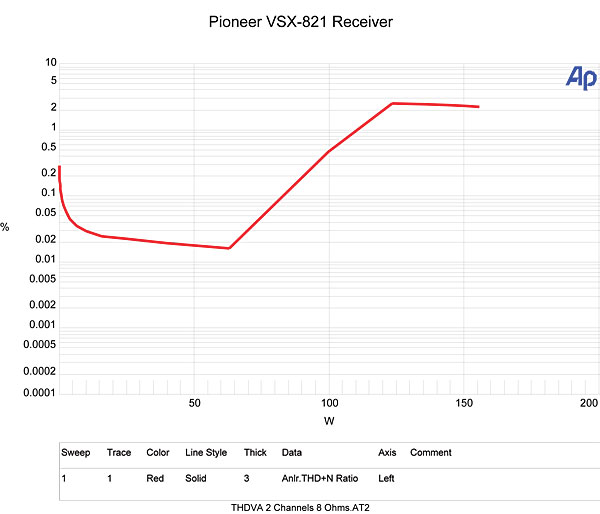Pioneer VSX-821 A/V Receiver HT Labs Measures
Five channels driven continuously into 8-ohm loads:
0.1% distortion at 63.2 watts
1% distortion at 78.1 watts
Analog frequency response in Pure Direct mode:
–0.22 dB at 10 Hz
–0.06 dB at 20 Hz
–0.13 dB at 20 kHz
–3.46 dB at 50 kHz.
Analog frequency response with stereo signal processing:
–0.47 dB at 10 Hz
–0.17 dB at 20 Hz
–0.65 dB at 20 kHz
–61.09 dB at 50 kHz.

This graph shows that the VSX-821's left channel, from CD input to speaker output with two channels driving 8-ohm loads, reaches 0.1% distortion at 82.9 watts and 1% distortion at 110.3 watts. Into 4 ohms, the amplifier reaches 0.1% distortion at 121.3 watts and 1% distortion at 150.7 watts.
There was no multichannel analog input to measure. THD+N from the CD input to the speaker output was less than 0.092% at 1 kHz when driving 2.83 volts into an 8-ohm load. Crosstalk at 1 kHz driving 2.83 volts into an 8-ohm load was –67.03 dB left to right and –63.24 dB right to left. The signal-to-noise ratio with an 8-ohm load from 10 Hz to 24 kHz with "A" weighting was –89.11 dBrA.
From the Dolby Digital input to the loudspeaker output, the left channel measures –0.13 dB at 20 Hz and –0.53 dB at 20 kHz. The center channel measures –0.08 dB at 20 Hz and –0.40 dB at 20 kHz, and the left surround channel measures –0.08 dB at 20 Hz and –0.58 dB at 20 kHz. From the Dolby Digital input to the line-level output, the LFE channel is –0.18 dB at 20 Hz when referenced to the level at 40 Hz and reaches the upper 3-dB down point at 118 Hz and the upper 6-dB down point at 120 Hz.—MJP
Video Test Bench
| 3:2 HD | 2:2 HD | MA HD | 3:2 SD | 2:2 SD | MA SD | VIDEO CLIPPING | LUMA RESOLUTION | CHROMA RESOLUTION | SCALING |
| N/A | N/A | N/A | N/A | N/A | N/A | Pass | Pass | Pass | N/A |
The Pioneer VSX-821 has passthrough video switching only, with no upconversion or deinterlacing. The resolution of the output is the same as the resolution of the input.
We are dropping our former analog tests (component in to HDMI out) from this and future Video Test Bench results. Many new source components are beginning to omit component-video outputs—or at least limiting their resolution, which means that HDMI is the only way to see full HD. Just as important, cross conversion (the component input to HDMI output signal path that our analog tests addressed) is primarily a convenience. Our tests have consistently shown that in virtually all cases, this configuration should be avoided if the best quality image is your goal.
























































